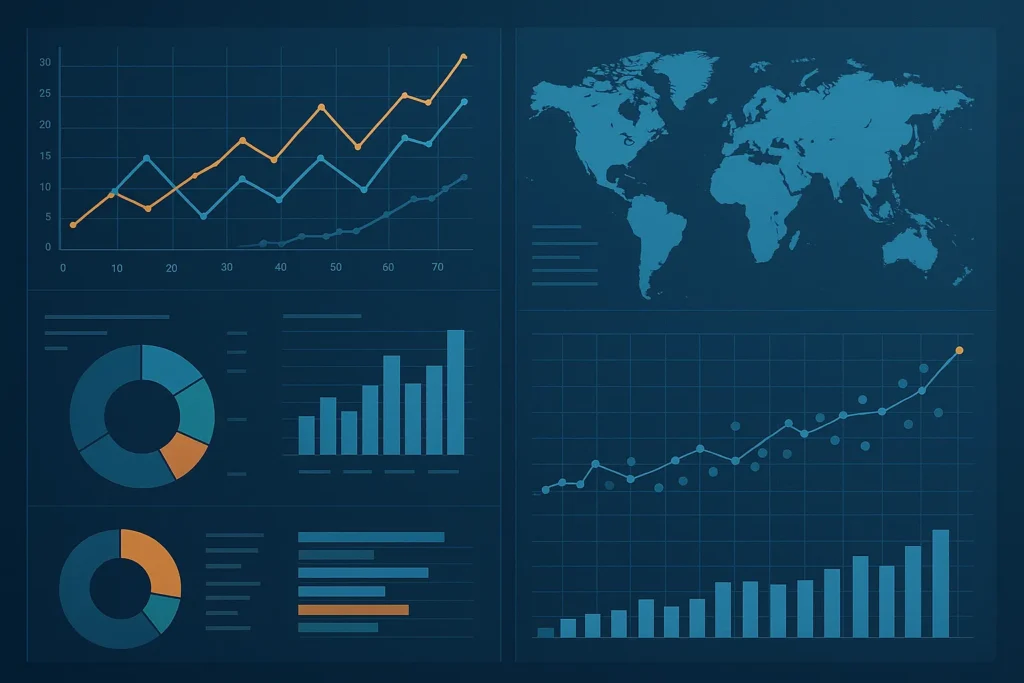You have spent time and effort creating a beautiful website. The content is solid, the design looks great, but visitors are still leaving too soon.
The problem is not your content. It is how that content is presented.
People process visuals 60,000 times faster than text, yet many websites rely on walls of words that users skim past. Without visual storytelling, data can feel overwhelming. When visitors cannot quickly grasp key details, they leave. This leads to higher bounce rates, fewer page views, and lower conversions.
Data visualization changes that. Through charts, heat maps, and infographics, websites can present information in a way that’s both clear and compelling. With the right approach, these tools highlight key insights, guide user behavior, and ultimately drive deeper engagement.
This article will show you how to:
- Use digital tools to create effective data visualization that improves website engagement
- Apply bar charts, pie charts, and heat maps to track user behavior
- Leverage social proof and customer testimonials to build credibility
- Optimize for mobile users and ensure visuals work across multiple devices
By the end, you will know exactly how to use data visualization to engage visitors, improve engagement metrics, and boost user retention.
Let’s get started.
Understanding Data Visualization and Why It Boosts Engagement
Imagine landing on a website filled with paragraphs of dense text. There are no visuals, no charts, and no interactive elements. Just words. Would you stay and read through everything? Probably not.
Now picture a website that presents information using engaging charts, interactive graphs, and heat maps. Instead of forcing visitors to process blocks of text, it highlights key insights instantly and intuitively. That’s what effective data visualization looks like.
What is Data Visualization?
Data visualization is the process of turning raw data into visual formats that make information easier to interpret. Businesses, marketers, and website owners use visualization methods like bar charts, pie charts, and heat maps to present complex data in a clear and engaging way.
Common examples include:
- Heat maps that track where users click and scroll on a webpage
- Bar charts and pie charts that show trends in web traffic and engagement metrics
- Infographics that simplify industry reports into easy-to-read summaries
When data is presented visually, visitors absorb it faster and more effectively. As a result, they spend more time on your site, interact with more content, and are more likely to convert.
How Data Visualization Improves Website Engagement

Many websites struggle with low user engagement because their content is not structured in a way that holds attention. Long paragraphs and static information do not encourage interaction, while effective data visualization does.
Here is how visual storytelling can transform website performance:
- Increases time on page: Users are more likely to stay longer when content is visually appealing and interactive.
- Boosts engagement metrics: Websites with interactive graphs and dynamic visuals encourage visitors to explore deeper.
- Improves decision-making: Visitors can make informed decisions faster when data is presented clearly through visualization methods.
- Enhances mobile experience: Mobile users find it easier to navigate websites with optimized visual elements, which improves usability across multiple devices.
The way a website presents information directly affects user behavior. Research from the Nielsen Norman Group shows that users typically read only 20 to 28 percent of the text on a webpage (source). When content is structured visually, it captures attention and guides users toward action.
For example, a SaaS company that integrated interactive dashboards on its homepage saw a 32 percent increase in user engagement within the first month. The right data visualization strategies make information easier to understand, keep users engaged, encourage exploration, and ultimately drive better outcomes.
Key Engagement Metrics and How Data Visualization Improves Them
Tracking engagement metrics is one of the most effective ways to improve ROI and reduce wasted effort. It reveals what visitors are clicking, reading, and ignoring, helping you focus on features that actually matter. But many analytics tools bury these insights under piles of raw numbers that are difficult to interpret.
That’s why we recommend data visualzation. According to BuzzSumo, articles with an image once every 75 to 100 words receive double the social media shares compared to articles with fewer images (source). This reinforces how visual content increases user attention and encourages interaction.
Visual formats like heat maps, scroll-depth charts, and click tracking reports help surface patterns that static dashboards often miss. A heat map can show which areas of a page attract the most attention.
A scroll report can reveal that users rarely reach the bottom of your content. When presented visually, these insights become clear and actionable, helping you optimize content layout, navigation, and calls-to-action to improve website engagement.
Here are the most important engagement metrics and how data visualization can help improve them.
1. Bounce Rate: How many visitors leave without interacting?
A high bounce rate means users are landing on your website but leaving quickly. This often happens when content is difficult to navigate or does not capture attention immediately.
How Data Visualization Helps:
- Heat maps show where users are clicking and which areas they ignore. This helps identify weak spots on the page.
- Bar charts and pie charts visualize where traffic is dropping off, making it easier to adjust content placement.
- Infographics and interactive elements keep users engaged and reduce bounce rates.
2. Time on Page: Are visitors staying long enough to absorb content?
The longer a visitor stays, the more engaged they are. If users leave quickly, the content may not be engaging or visually appealing enough. But it’s not just about losing a potential lead. A low time on page can also hurt your search engine rankings.
Google uses dwell time, which measures how long someone stays before returning to the search results, as a signal of content quality. If people consistently bounce after a few seconds, it suggests the page isn’t delivering what they expected. That can lead to reduced visibility in search results over time.
Using data visualization to break up dense text, highlight key points, and guide users down the page can increase time on site and send stronger engagement signals to search engines.
How Data Visualization Helps:
- Interactive data charts and infographics make content more engaging, increasing session duration.
- Visualization methods like bar charts and pie charts help present data in a way that encourages further exploration.
- Social proof elements such as customer testimonials and recent sign-ups add credibility and keep users interested.
3. Click-Through Rate (CTR) – Are visitors interacting with links and CTAs?
A low CTR means users are not clicking on important elements, such as internal links, product pages, or call-to-action buttons. This often signals that either the visual hierarchy is unclear or the elements don’t feel relevant or compelling enough to prompt action.
If users aren’t clicking, they’re not progressing through your site, which stalls conversions and weakens overall engagement. Visualizing click data through heat maps or interaction graphs can reveal which areas are working and which ones are being ignored.
How Data Visualization Helps:
- Comparison charts and product visuals make it easier for users to decide what to click on.
- Heat maps reveal whether visitors notice important buttons or if they need better placement.
- Infographics and visually appealing CTAs make users more likely to take action.
4. Scroll Depth: Are users reading the entire page?
If visitors are not scrolling past the first few paragraphs, important content may be getting ignored. This often means your introduction isn’t strong enough to pull readers down the page, or that the layout feels overwhelming at first glance.
Key information placed too far down may never be seen. Tracking scroll depth helps identify where interest drops off, so you can restructure content placement, add visual cues, or break up long blocks of text to keep readers moving.
How Data Visualization Helps:
- Progress indicators show users how much content is left, encouraging them to keep scrolling.
- Visual storytelling with infographics guides users naturally through the page.
- Mobile-friendly design elements ensure content is easy to navigate across multiple devices.
Tracking these engagement metrics provides a clear picture of how well a website is performing. When data visualization is used correctly, it can help engage users, reduce bounce rates, and boost engagement across mobile devices and desktops.
Top Digital Tools for Creating Effective Data Visualizations
If you want people to really connect with your data and understand the story behind it, the right tool can make all the difference. These tools help make your content clearer, more interactive, and way more engaging. Here are a few great options, each with something special to offer:
1. Chart.js
Chart.js is a lightweight JavaScript library that makes it simple to create clean, responsive charts using just a few lines of code. It supports a variety of chart types including bar, line, and pie charts, and renders beautifully on both desktop and mobile. One reason developers like Chart.js is how quickly you can get a visual live on your site without dealing with complex setup.
2. Infogram
Infogram is popular with marketing teams and newsrooms because it lets you create shareable visuals in minutes. You don’t need to know how to code. Just plug in your data, pick a template, and publish or embed it. It works especially well for turning reports or campaign results into polished, easy-to-share graphics.
3. Plotly
Plotly offers tools for both beginners and power users. With its drag-and-drop Chart Studio, anyone can build interactive graphs. For more technical users, Plotly’s Dash framework lets you build full web apps using Python or R. This flexibility is one reason it’s used in everything from business dashboards to scientific research.

4. RAWGraphs
RAWGraphs is a great choice when you need more than just standard charts. It supports less common but highly useful formats like alluvial diagrams, bump charts, and treemaps. If you work with complex data and want your visual output to stand out, RAWGraphs is worth exploring.
5. D3.js
D3.js is ideal for developers who want full control over their visuals. Instead of giving you ready-made templates, it lets you build custom data-driven visuals from scratch using HTML, SVG, and CSS. It takes time to learn, but you gain the ability to create highly interactive and unique visual experiences.
6. Google Gemini AI in Sheets
Google Sheets now includes Gemini AI, which helps users visualize data by asking simple questions. You can request a chart, spot trends, or even generate summaries based on your spreadsheet content. This feature is especially useful for teams that want quick insights without hiring a full-time data analyst. (Source: The Verge)
Overcoming Challenges in Implementing Data Visualization
So now the million dollar question: how do we turn thousands of data points into something clean and simple for people to understand? Adding charts to your website sounds great until they slow everything down, show misleading patterns, or just plain break on phones.
Without proper implementation, visual elements may slow down your site, misrepresent user behavior, or fail to work on mobile devices. Thankfully, we’ve seen it all already and know how to proactively fix these things BEFORE they become an issue.
Below are common issues and how to solve them.
1. Data Quality and Accuracy
A poorly designed visualization based on raw data that has not been cleaned can mislead users. Quantitative data must be accurate to build credibility and support decision-making.
Solution: Regularly validate and clean your data before turning it into bar charts, pie charts, or heat maps. Using analytics tools like Google Analytics or Google Workspace for data tracking helps ensure accuracy.
2. Choosing the Right Visualization Method
Not all visualization methods work for every dataset. Bar charts work well for comparing specific values, while pie charts help illustrate proportions. Using the wrong format can create confusion instead of clarity.
Solution: Select the right chart for your data, keeping in mind the target audience and the message you want to communicate.
For example, if you’re showing monthly revenue across different departments, a bar chart will make it easy to compare performance side by side.
But if you’re breaking down a marketing budget into categories like ads, software, and events, a pie chart helps show how each category fits into the whole.
3. Optimizing Visuals for Mobile Users
More than 60% of internet traffic now comes from mobile devices, so your visuals must adapt to different screen sizes. If your charts are not mobile-friendly, users may leave due to poor usability.
Solution: Use responsive design techniques and lightweight visualization frameworks. Read about how Google’s search engine is becoming much smarter and how mobile indexing affects engagement.
4. Ensuring Website Performance & Speed
Complex data visualization elements can increase HTTP requests and slow down your website, affecting page views and bounce rates.
Solution: Compress images, minimize unnecessary scripts, and use efficient data processing tools to optimize load speed. Learn more about how website speed affects SEO and engagement.
5. Accessibility & User-Friendly Design
If your visuals are not designed with accessibility in mind, they may exclude a portion of your target audience.
Solution: Add text descriptions, high-contrast color schemes, and interactive tooltips to make visuals more user-friendly for all audiences. Making data visualization accessible ensures inclusivity and improves internal usability within teams.
By overcoming these challenges, website owners can create engaging, visually appealing content that enhances user experience and website engagement. Next, we will look at real-world case studies of websites that successfully used data visualization to boost engagement and increase conversions.
Real-World Case Studies: How Websites Use Data Visualization to Boost Engagement
We want to share a few real-world case studies so you can see exactly how businesses across different industries are using data visualization to turn dry data into something people actually want to engage with.
These examples highlight how visual content can improve user experience, increase interaction, and ultimately drive results. This applies whether you’re in media, eCommerce, or tech.
1. The New York Times: Interactive Journalism with Data Visualization
The New York Times is widely recognized for using data journalism to create engaging, interactive reports. By using visualization methods like heat maps, pie charts, and bar charts, they make complex topics more accessible to readers. A notable example is their COVID-19 tracking dashboard, which provided real-time updates on infection rates using interactive maps and graphs.
According to a study published by Harvard’s Nieman Lab, users spent three times longer on articles that included interactive graphics compared to text-only reports. This shows that engaging website elements like data-driven visuals significantly boost engagement and user behavior tracking.
2. Spotify: Personalization Through Data Visualization
Spotify uses data visualization to enhance the user experience with features like Spotify Wrapped, which presents users with personalized listening statistics through vibrant charts and graphs. This annual feature generates massive engagement, with millions of users sharing their results on social media.
A report from Business Insider highlights how Spotify Wrapped increased user engagement by 60%, as listeners spent more time exploring their personalized data. This demonstrates how well-designed data visualization can engage users by making information visually appealing and easy to digest.
3. Amazon: Using Heat Maps to Optimize Product Pages
Amazon uses heat maps to analyze user behavior on product pages and optimize the placement of key elements like pricing, images, and customer reviews. According to a case study published by Baymard Institute, improving visual storytelling on product pages helped increase conversion rates by 35%.
Amazon’s approach shows that visualizing user interactions through heat maps and quantitative data allows businesses to make informed decisions that improve the shopping experience for potential customers.
Key Takeaways
These case studies show that data visualization is a powerful tool for improving website engagement across industries. News outlets use it to report complex topics more clearly. SaaS platforms personalize user dashboards with it.
eCommerce brands rely on it to guide customer decisions. In each case, the right visualization method helps keep visitors engaged and encourages them to take action.
Actionable Steps to Implement Data Visualization on Your Website
Now that we have explored how data visualization improves website engagement, let’s look at practical ways to implement it effectively. eCommerce brands, content websites, and SaaS platforms can all benefit from the following steps to create engaging, data-driven visuals. These approaches help track user behavior more effectively and lead to stronger engagement.

1. Identify Key Engagement Metrics to Visualize
Before adding visualization methods to your website, determine which data points matter most. Some essential engagement metrics to track include:
- Bounce rates and page views to understand visitor retention
- Click-through rates (CTR) to measure interactions with calls to action
- User feedback and customer testimonials to enhance credibility
- Mobile users vs. desktop users to optimize visuals for multiple devices
Using tools like Google Analytics, heat maps, and session recordings can help pinpoint which areas of your website need visual improvements.
2. Choose the Right Visualization Tools
There are many digital tools available to help create effective data visualization. Some of the best options include:
- Google Workspace (Google Sheets & Data Studio) for real-time data tracking
- Tableau and Power BI for advanced business analytics
- D3.js and Chart.js for creating interactive bar charts and pie charts
- Infogram and Canva for user-friendly infographics
Each tool has its strengths, so choose one that aligns with your website’s marketing strategy and data needs.
3. Optimize Visuals for Mobile Users
More than 50% of web traffic comes from mobile devices, making it important to ensure that your visuals are mobile-friendly.
- Use responsive design elements that adjust to different screen sizes
- Optimize images and reduce HTTP requests to improve page speed
- Test interactive elements to ensure smooth performance on multiple devices
A well-optimized site provides a better experience for mobile users, increasing website engagement and reducing bounce rates.
4. Leverage Social Proof Through Data Visualization
Trust plays a huge role in conversions. Using data visualization to display customer testimonials, recent sign-ups, and engagement metrics can build credibility and encourage new visitors to take action.
For example, websites often showcase:
- Live visitor counts and social shares to reinforce popularity
- Ratings and reviews in a graphical format to improve decision-making
- Customer churn and retention data to highlight service quality
Including real-time assistance and customer satisfaction metrics makes data-driven trust signals more compelling.
5. Continuously Monitor and Improve Visualizations
Data visualization should be a dynamic process. Regularly review your visuals and update them based on new insights.
- Analyze heat maps and user behavior data to refine placement
- A/B test different visualization methods to determine what works best
- Use analytics tools to track engagement trends and improve designs
Staying proactive ensures that your visual storytelling remains relevant and continues to boost engagement.
By following these steps, website owners can transform raw data into visually compelling content that engages users and drives conversions.
Final Thoughts and Next Steps
Implementing data visualization is one of the most effective ways to boost engagement and improve the way users interact with your website. Tracking user behavior, improving mobile-friendly designs, and leveraging social proof all become more effective when supported by the right visualization methods. These approaches help turn raw data into clear, actionable insights.
By now, you should have a clear understanding of how bar charts, pie charts, heat maps, and other visualization tools can help engage visitors, reduce bounce rates, and improve engagement metrics. When used strategically, data visualization can transform a static website into an engaging platform that encourages deeper interaction.
Your Next Steps
Now is the time to put these insights into action. Here’s what to do next:
- Evaluate your current website analytics to determine which data points need better visualization.
- Choose the right digital tools for your needs, whether that’s Google Workspace, Tableau, or Infogram.
- Implement mobile-friendly designs to ensure your charts and visuals are optimized for multiple devices.
- Use real-time data tracking to make informed decisions based on user interactions.
- Monitor engagement improvements and refine your visuals using A/B testing and analytics tools.
For more insights on optimizing your website’s performance, check out Accuvantlabs.com on data-driven strategies to enhance engagement and conversions.
Start transforming your website today with smarter data visualization techniques. The right tools and strategies will help you engage users, increase conversions, and build long-term success.




